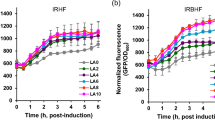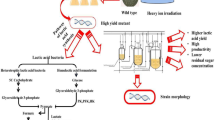Abstract
Two DNA fragments containing the entire coding sequences of lactate dehydrogenase (LDH; ldhL1 and ldhD), whose enzymes have high activity for bioconversion of phenylpyruvate (PPA) to phenyllactate (PLA), were amplified from Lactobacillus plantarum SK002 using PCR. Sequencing showed open reading frames of 963 bp (ldhL1) and 999 bp (ldhD) encoding putative proteins of 320 and 332 amino acid residues, respectively. The LDH genes were cloned into an expression vector pET-22b(+) and expressed in Escherichia coli BL21(DE3). The purified recombinant l1-LDH and d-LDH had approximate (SDS-PAGE) molecular weights of 35 and 40 kDa, respectively. l1-LDH and d-LDH had PPA bioconversion specific activities of 71.06 and 215.84 U/mg with K m values of 3.96 and 5.4 mM, respectively. The rl1-LDH and rd-LDH showed maximum enzyme activity at 30 and 40 °C while both had optimum activity at pH 6.0. l1-LDH exhibited a higher pH and temperature stability than d-LDH. The results show that the his-tagged L. plantarum SK002 d- and l1-LDHs are efficient catalysts for bioconversion of PPA to PLA.






Similar content being viewed by others
References
Ohhira, I. Kuwaki, S. Morita, H. Suzuki, T. Tomita, S. Hisamatsu, S. et al. (2004). Biocontrol Science, 9(3), 77–81.
Lavermicocca, P. Valerio, F. & Visconti, A. (2003). Applied and Environmental Microbiology, 69(1), 634–640. doi:10.1128/AEM.69.1.634-640.2003.
Valerio, F. Lavermicocca, P. Pascale, M. & Visconti, A. (2004). FEMS Microbiology Letters, 233(2), 289–295. doi:10.1111/j.1574-6968.2004.tb09494.x.
Strom, K. Sjogren, J. Broberg, A. & Schnurer, J. (2002). Applied and Environmental Microbiology, 68(9), 4322–4327. doi:10.1128/AEM.68.9.4322-4327.2002.
Coloretti, F. Carri, S. Armaforte, E. Chiavari, C. Grazia, L. & Zambonelli, C. (2007). FEMS Microbiology Letters, 271(2), 245–250. doi:10.1111/j.1574-6968.2007.00723.x.
Vermeulen, N. Ganzle, M. G. & Vogel, R. F. (2006). J. Agric. Food Chem, 54(11), 3832–3839. doi:10.1021/jf052733e.
Li, X. Jiang, B. & Pan, B. (2007). Biotechnology Letters, 29(4), 593–597. doi:10.1007/s10529-006-9275-4.
Mu, W. Chen, C. Li, X. Zhang, T. & Jiang, B. (2009). Bioresource Technology, 100(3), 1366–1370. doi:10.1016/j.biortech.2008.08.010.
Li, X. Jiang, B. Pan, B. Mu, W. & Zhang, T. (2008). Journal of Agricultural and Food Chemistry, 56(7), 2392–2399. doi:10.1021/jf0731503.
Gaspar, P. Neves, A. R. Shearman, C. A. Gasson, M. J. Baptista, A. M. et al. (2006). FEBS Journal, 274(22), 5924–5936. doi:10.1111/j.1742-4658.2007.06115.x.
Okano, K. Zhang, Q. Shinkawa, S. Yoshida, S. Tanaka, T. Fukuda, H. et al. (2009). Applied and Environmental Microbiology, 75(20), 462–467. doi:10.1128/AEM.01514-08.
Hummel, W. (1999). Trends in Biotechnology, 17(12), 487–492. doi:10.1016/S0167-7799(98)01207-4.
Razeto, A. Kochhar, S. Hottinger, H. Dauter, M. Wilson, K. S. & Lamzin, V. S. (2002). Journal of Molecular Biology, 318(1), 109–1. doi:10.1016/S00222836(02)00086-4.
Kleerebezem, M. Boekhorst, J. Kranenburg, R. Molenaar, D. Kuipers, O. P. Leer, R. et al. (2003). Proceedings of the National Academy of Sciences, 100(4), 1990–1995. doi:10.1073/pnas.0337704100.
Jia, J. Mu, W. Zhang, T. & Jiang, B. (2009). Food and Fermentation Industries, 35(5), 22–25.
Sambrook, J. & Russell David, D. W. (2002). Molecular Cloning: A Labaratory Manual, 3, 1252–1255.
Hummel, W. Schütte, H. & Kula, M. R. (1983). Applied Microbiology and Biotechnology, 18(2), 75–85. doi:10.1007/BF00500828.
Copeland, R. A. (2000). Enzymes: A Practical Introduction to Structure, Mechanism, and Data Analysis (pp. 124–128). Wiley: New York.
Origin Lab Corporation. (2003). Origin Pro 7.5 SRI. Version 7.5776(B776). Northampton MA. 01060. USA. www.originlab.com
Taguchi, H. & Ohta, T. (1991). Journal of Biological Chemistry, 266(19), 12588–12594.
Cristescu, M. E. Innes, D. J. Stillman, J. H. & Crease, T. J. (2008). BMC Evolutionary Biology, 8(1), 268. doi:10.1186/1471-2148-8-268.
Savijoki, K. & Palva, A. (1997). Applied and Environmental Microbiology, 63(7), 2850–2856.
Tokuda, C. Ishikura, Y. Shigematsu, M. Mutoh, H. Tsuzuki, S. Nakahira, Y. et al. (2003). Journal of Bacteriology, 185(16), 5023–5026. doi:10.1128/JB.185.16.5023-5026.2003.
Arai, K. Kamata, T. Uchikoba, H. Fushinobu, S. Matsuzawa, H. & Taguchi, H. (2001). Journal of Bacteriology, 183, 397–400. doi:10.1128/JB.183.1.397-400.2001.
Acknowledgement
This work was supported by the grants from the National High Technology “863” Program of China, project No. 2006AA10Z334, the Natural Science Foundation of Jiangsu Province, project No. BK2008099 and BK2008003, the Research Program of State Key Laboratory of Food Science and Technology, Jiangnan University, project No. SKLF-MB-200804 and SKLF-TS-200805, and the Program for Innovative Research Team of Jiangnan University, project No. 2008CXTD01.
Author information
Authors and Affiliations
Corresponding author
Rights and permissions
About this article
Cite this article
Jia, J., Mu, W., Zhang, T. et al. Bioconversion of Phenylpyruvate to Phenyllactate: Gene Cloning, Expression, and Enzymatic Characterization of d- and l1-Lactate Dehydrogenases from Lactobacillus plantarum SK002. Appl Biochem Biotechnol 162, 242–251 (2010). https://doi.org/10.1007/s12010-009-8767-9
Received:
Accepted:
Published:
Issue Date:
DOI: https://doi.org/10.1007/s12010-009-8767-9




